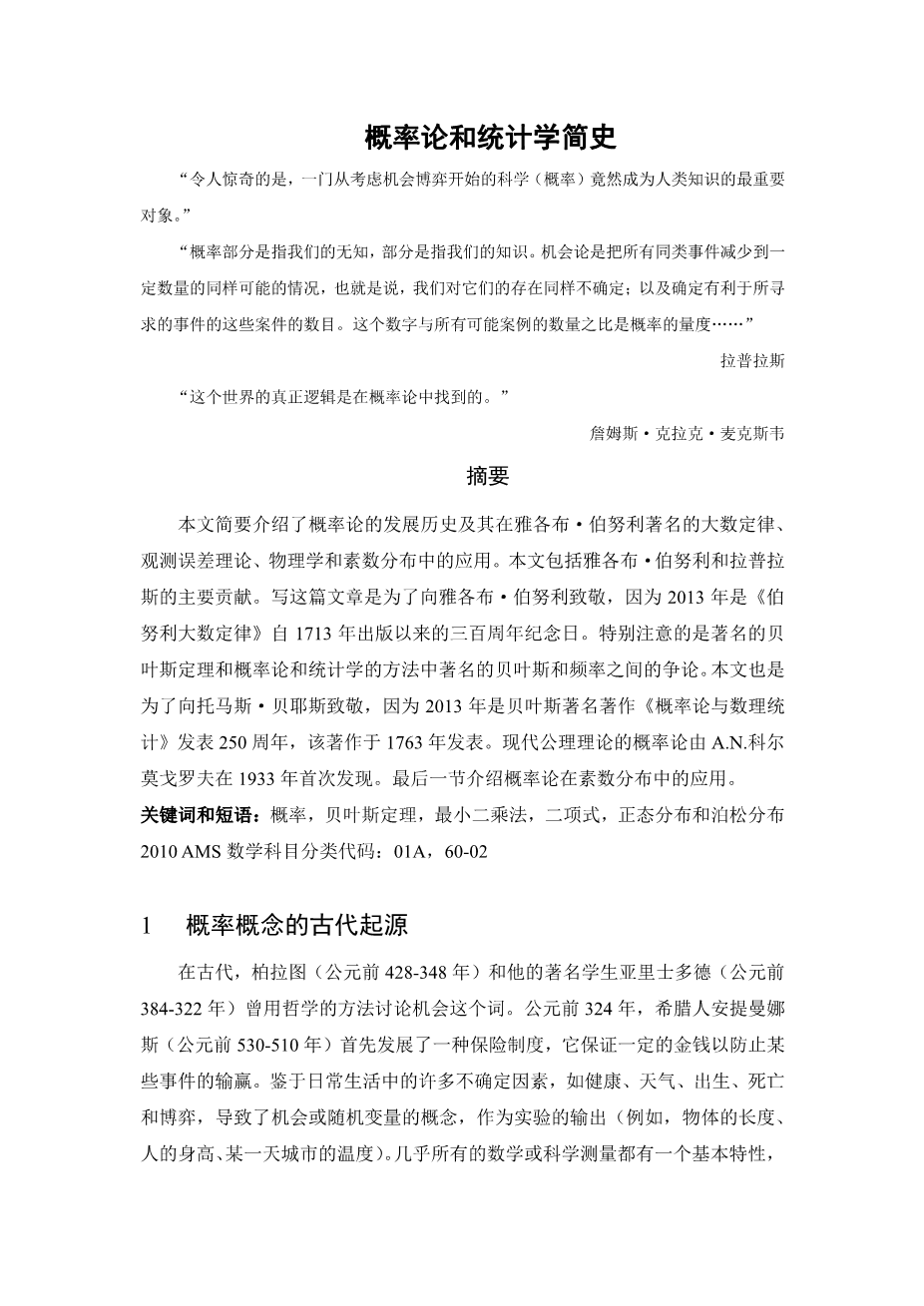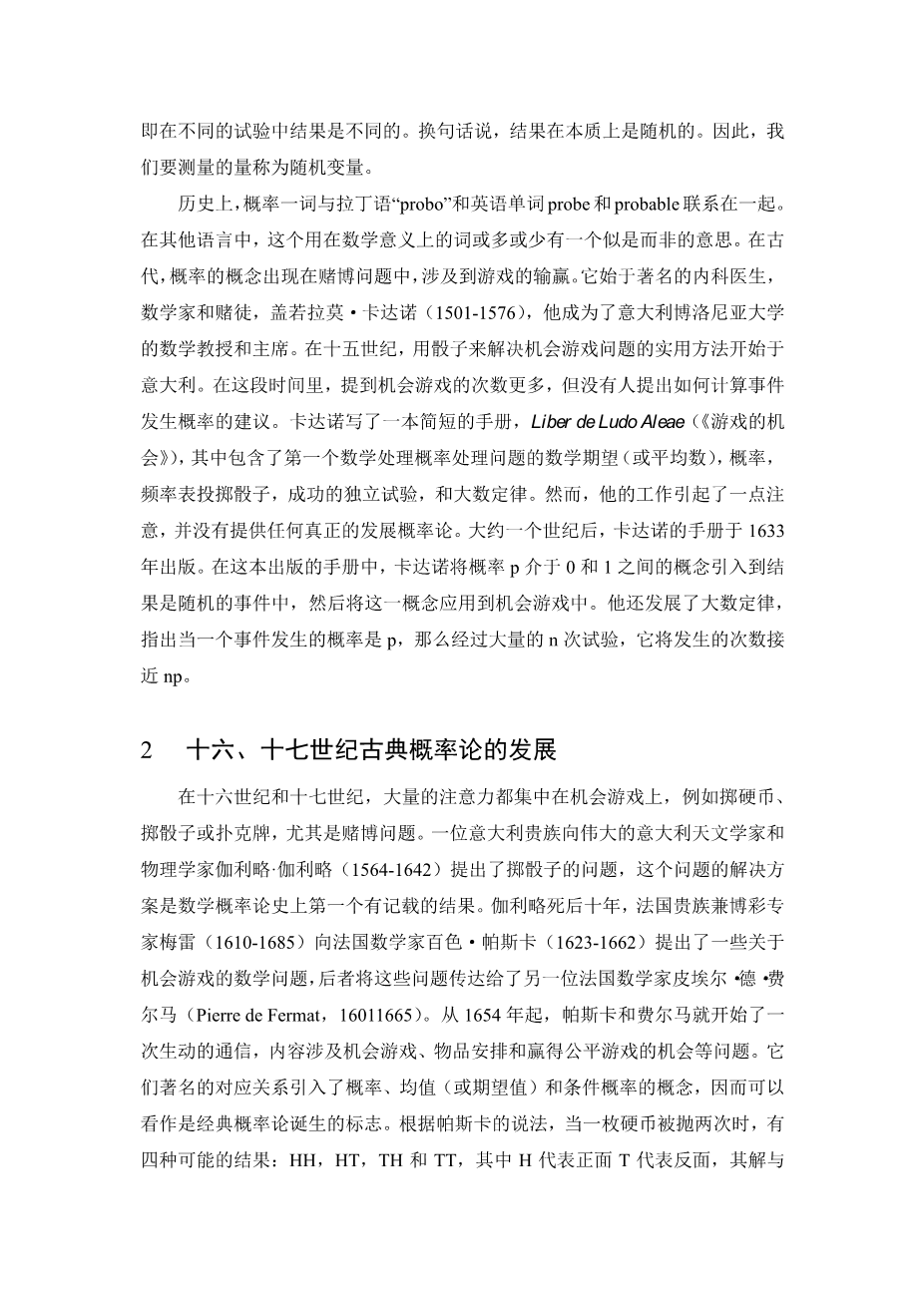A short History of Probability and Statistics
“It is remarkable that a science (Probability) which began with consideration of games of chance, should have become the most important object of human knowledge.”
“Probability has reference partly to our ignorance, partly to our knowledge. The Theory of chances consists in reducing all events of the same kind to a certain number of cases equally possible, that is, such that we are equally undecided as to their existence; and determining the number of these cases which are favourable to the event sought. The ratio of that number to the number of all the possible cases is the measure of the probability ”
P.S. Laplace
“The true logic of this world is to be found in theory of probability.”
James Clark Maxwell
Abstract
This paper deals with a brief history of probability theory and its applications to Jacob Bernoullirsquo;s famous law of large numbers, theory of errors in observations, physics and the distribution of prime numbers. Included are major contributions of Jacob Bernoulli and Laplace. It is written to pay the tricentennial tribute to Jacob Bernoulli, since this year 2013 marks the tricentennial anniversary of the Bernoullirsquo;s law of large numbers since its publication in 1713. Special attention is given to the Bayes celebrated theorem and the famous controversy between the Bayesian and frequentism approaches to probability and statistics. This article is also written to pay a special tribute to Thomas Bayes since this year 2013 marks the 250th anniversary of the Bayes celebrated work in probability and statistics, since its posthumous publication in 1763. This is followed by the modern axiomatic theory of probability first discovered by A.N. Kolmogorov in 1933. The last section is devoted to applications of probability theory to the distribution of prime numbers.
Keywords and phrases: probability, Bayes theorem, least squares, binomial, normal and Poisson distributions
2010 AMS Mathematics Subject Classification Codes: 01A, 60-02
- Ancient Origins of the Concept of Probability
In ancient times, Plato (428-348 BC) and his famous student, Aristotle (384-322 BC) used to discuss the word chance philosophically. In 324 BC, a Greek person, Antimenes (530-510 BC) first developed the system of insurance which guaranteed a sum of money against wins or losses of certain events. In view of many uncertainties of everyday life such as health, weather, birth, death and game that led to the concept of chance or random variables as output of an experiment (for example, the length of an object, the height of people, the temperature in a city in a given day). Almost all measurements in mathematics or science have the fundamental property that the results vary in different trials. In other words, results are, in general, random in nature. Thus, the quantity we want to measure is called a random variable.
Historically, the word probability was associated with the Latin word lsquo;proborsquo; and the English words, probe and probable. In other languages, this word used in a mathematical sense had a meaning more or less like plausibility. In ancient times, the concept of probability arose in problems of gambling dealing with winning or losing of a game. It began with famous physician, mathematician and gambler, Gerolamo Cardano (1501-1576) who became Professor and Chair of mathematics at the University of Bologna in Italy. During the fifteenth century, the pragmatic approach to problems of games of chance with dice began in Italy. During that time, references to games of chance were more numerous, but no suggestions were made how to calculate probabilities of events. Cardano wrote a short manual, Liber de Ludo Aleae (Games of Chance) which contained the first mathematical treatment of probability dealing with problems of mathematical expectation (or mean), addition of probability, frequency tables for throwing of a dice, n successes in n independent trials, and the law of large numbers. However, his work attracted a little attention and did not provide any real development of probability theory. Cardanorsquo;s manual was published in 1633 about a century later. In this published manual, Cardano introduced the idea of probability p between 0 and 1 to an event whose outcome is random, and then applied this idea to games of chance. He also developed the law of large numbers which states that when the probability of an event is p, then after a large number of trials n, the number of times it will occur is close to np.
- Development of Classical Probability During the Sixteenth and Seventeenth Centuries
During the sixteenth and seventeenth centuries, a great deal of attention was given to games of chance, such as tossing coins, throwing dice or playing cards, in particular, and to problems of gambling, in general. An Italian nobleman suggested a problem of throwing dice to Galileo Galilei (1564-1642), a great Italian astronomer and physicist, a solution of which was the first recorded result in the history of mathematical probability theory. A decade after Galileorsquo;s death, a French nobleman and gambling expert, Chevalier de Meacute;re (1610-1685) proposed some mathematical questions on games of chance to Baise Pascal (1623-1662), French mathematician, who communicated these to another French mathematician, Pierre de Fermat (1601- 1665). From 1654, both Pascal and Fermat began a lively correspondence about questions and problems dealing with games of chance, arrangements of objects, and chance of winning a fair game. Their famous correspondence introduced the concept of probability, mean (or expected) value and conditional
剩余内容已隐藏,支付完成后下载完整资料


英语译文共 11 页,剩余内容已隐藏,支付完成后下载完整资料
资料编号:[405213],资料为PDF文档或Word文档,PDF文档可免费转换为Word
您可能感兴趣的文章
- 质量管理体系:确保全面质量管理的一个急需的工具外文翻译资料
- 识别MOBA游戏中具有预测性的胜利团战模式外文翻译资料
- 曲线拟合和最小二乘法来推断埃塞俄比亚COVID-19病例状态外文翻译资料
- 欧洲区域政策与欧洲区域社会经济多样性:多元分析外文翻译资料
- 公共企业资源规划公司估值的关键指标和关键驱动因素外文翻译资料
- 结构方程建模中模型评估的统一方法外文翻译资料
- Fisher线性判别函数的“朴素贝叶斯”,以及变量多于观测 值情况下的一些替代方法外文翻译资料
- 变量对于分类的贡献外文翻译资料
- 多时间尺度自相关和交互相关多元分位数投影变换偏差订正降尺度模型外文翻译资料
- 与可交换性结合时随机缺失和相关定义的注释外文翻译资料


